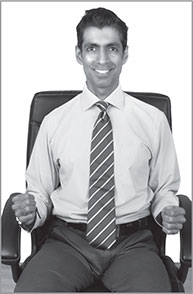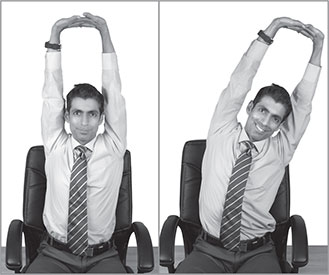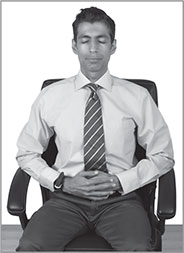Chapter 16
ANYTIME ANYWHERE STRETCHES
Life is like riding a bicycle. To keep your balance, you must keep moving.
~ Albert Einstein
T he human body is designed to be physically in motion; there is no room for lethargy and long, sedentary spells. In spite of this knowledge, man indulges in comforts and luxuries. Studies have shown that musculoskeletal back problems are the largest cause of disability among working people and that 30% of these problems become chronic.
Sitting with an elongated back and neck, without a forward or backward tilt, makes for a graceful posture. But, however graceful and attractive a posture be, it is important to remember to avoid sitting for more than thirty minutes in the same position. Find a good reason, or a flimsy one, for a refreshing break. A couple of minutes off, perhaps just to say a casual hello to a workmate or to have a sip of water. This small break nourishes the body and the mind. Smile without a reason, feel good about yourself, and watch the stress levels deplete and the breaths become calm and harmonious. These feel good tips do not cost money or time; only your positive intention!
Practising right workplace ergonomics to correct the posture is an effective way to work energetically. Some specific exercises for the neck and the back can further improve the posture and the personality.
Stretch the Body, Stretch the Mind
For a positive and cheerful outlook at work, remember to be kind to the neck and the spine. Encourage the movements they are designed for. This may keep even the Monday morning blues at bay. Sometimes a grumpy, irritable, frowning attitude may be due to low-intensity discomfort in the neck region.
- It is recommended that you take a five minute break every hour or so.
- A variety of exercises have been described here to address various problems that people generally have. You can pick the ones you need for your specific issue.
- You can set up a routine where you do a few different ones at each break, without letting the number of exercises overwhelm you. Do whatever and how much ever you can and reap the benefits.
- For each exercise, hold the posture at its final position for ten seconds. Release and repeat each exercise ten times. This way, you can pick three exercises for each five-minute break.
- Breathe mindfully when you maintain a pose. Do not hold your breath at any time.
Office Practices for Neck, Upper Back and Shoulders

Wrong – Chin jutting Right – head glide
Head Glide
Aligns the head, the neck and the upper back
- Refer to page 135, Chapter 14.
Neck Stretch
Stretches the muscles at the sides of the neck

Side neck stretch
- Do the head glide, as mentioned before.
- Hold the left side of your forehead with your right hand.
- Gently pull the head to the right side.
- Feel a comforting stretch along the left side of the neck.
- Hold the position for three breaths.
- Release gently.
- Repeat on other side.
- Repeat two more times on both sides.
T Arms
Corrects rounded shoulders and the 'hot spot' sensation in the upper back
- Refer to page 144, Chapter 15.

T arms
Head Press
Releases strain in the neck
- Interlock your hands behind your head, palms facing the head.
- Press the head against the resistance of the hands as you try to push your head with your hands. Use counter-resistance to find release in the neck.
- Hold for ten counts.
- Release and repeat ten times.

Head press
Elbow Press
Tones the upper back
- Sit tall on your chair facing a table.
- Place your elbows on the table such that the palms face each other, while the fingers and the thumbs point towards the ceiling.
- Make sure your neck and shoulders are relaxed.
- Press your elbows on the table. This will lower your shoulders, increasing the distance between them and your ears.
- Hold for ten counts to engage the upper back.
- Release and repeat ten times.

Elbow press
Chair Press
Tones the lower back and the core and strengthens the back
This is an instant lower back and belly strengthening practice for those with an overarched lower back and weak abdominals.
- Sit tall on a chair.
- Make sure that your bottom is touching the back of the seat.
- As you exhale, pull the belly button in and let your lower back make full contact with the back of the seat.
- Hold for ten counts.
- Release and repeat ten times.

Chair press
Side bends
Loosen and strengthen the spine on either side
- Slide to the edge of the chair and sit upright.
- Interlock the fingers and lift the arms over your head.
- Keep the elbows straight, turn the interlocked palms upwards to face the ceiling.
- Push up your wrists rather than just the fingers.
- The breathing will now be deep and invigorating.
- As you exhale, slowly bend to one side and feel the stretch.
- Make sure the upper side of your body does not leaning forward.
- Hold the position for ten counts.
- Inhale as you come back to the centre.
- Repeat on the other side.
- Repeat the cycle three more times.

Side bends
Partial Forward Bend – Parvatasana with Wall Support (Mountain Pose with Wall Support)
Lengthens and stretches the spine.
- Refer to page 120, Chapter 12.

Partial forward bend
Back Bend
Expands the chest and reverses the slouch
- Sit tall at the edge of a chair.
- Place the fingertips of your hands on the seat, just behind your hips.
- Inhale and elongate the spine.
- Let the navel get pulled in as you lift the chest up.
- Hold for ten counts.
- Release and repeat three more times.

Back bend
Chair Twist
Releases stiff back
- Sit on a chair, with one side of your body towards the back of the chair.
- Hold the back of the chair with both your hands at the chest level.
- Twist from the waist.
- Lengthen the spine and deepen the twist.
- Make sure your navel is tucked in and is pointing towards the back of the chair.
- Hold the stretch for ten counts.
- Release and repeat on the other side.
- Repeat two more times on both sides.

Chair twists
Whenever you get a chance or whenever you realise that your muscles have gone loose, bring some tone in them. Your mantras are:
- Navel In (Refer page 46, chapter 6.)
- Clench the hips (Refer page 47, chapter 6.)
You can relax any tense muscle by breathing slow and deep, with the entire focus on the tight zone.
- As you inhale through the nose, imagine you are inhaling into the area where your muscles feel tight or uncomfortable. It could be your neck, the upper back, or the waist region.
- As you exhale through the nose, imagine you are breathing out through the pores of the same area. Consciously relax the area as you feel all the tension release with the exhalations.
- Take a few breaths in this manner. You might feel the discomfort increase in the first few breaths. But soon enough, you will sense a release.

Mindful breathing
Intermittent stretches while on the chair, or what we call office yoga – frequent breaks, small walks in the office, wriggling the toes, rotating the ankles, flexing and stretching the knees, side-to-side hip movement, shoulder rotations, facial massage with warm palm – goes a long way in maintaining good posture. Run your hands lightly over the tired calves, thighs, abs, back, shoulders, neck, face and head. This can be an endearing experience while sitting on the chair itself. The best part is that nobody around will even suspect that you have had a complete postural work out. They will only see the result in a fatigue-free you.